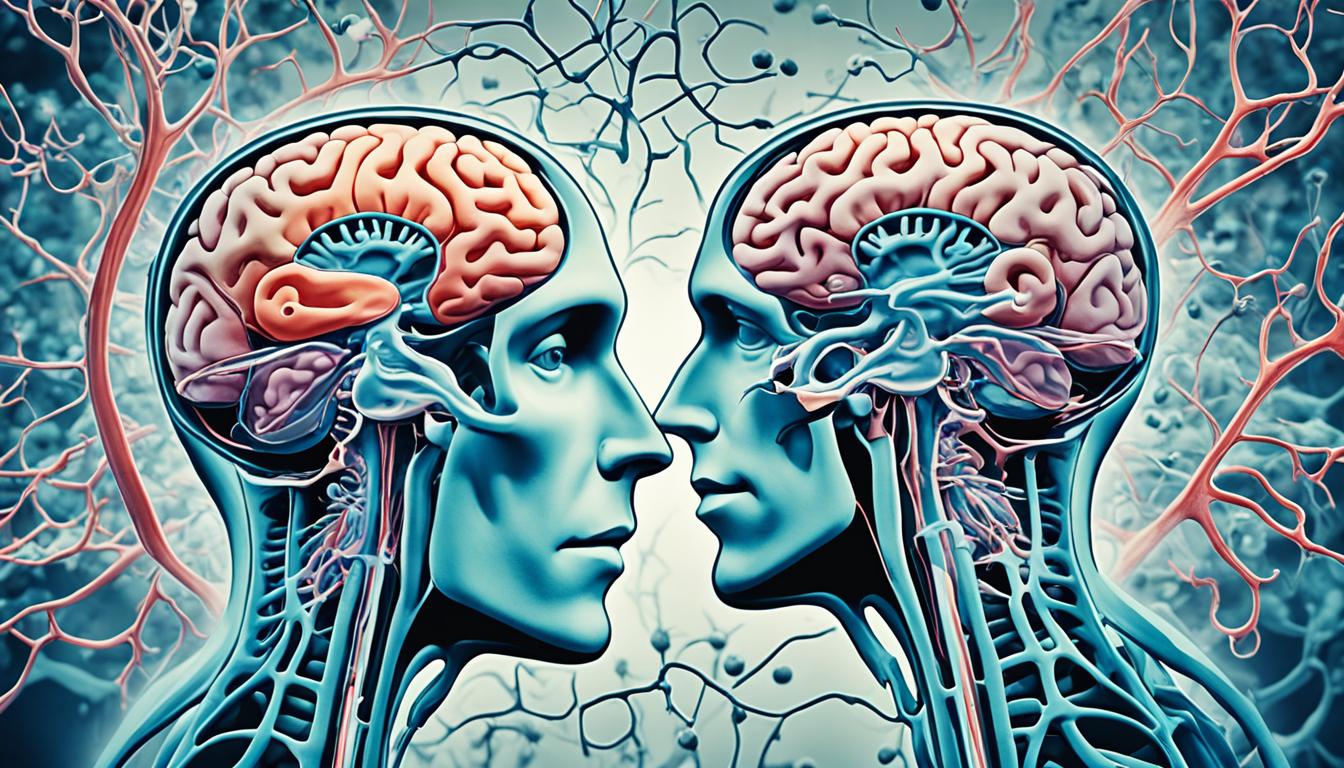Pick’s disease is a type of frontotemporal dementia. It affects the frontal and temporal brain lobes. These parts control language, memory, and behavior.
People with Pick’s disease may find it hard to talk. They might forget things and act differently. They might also avoid spending time with their loved ones.
This disease is linked to damage in specific brain areas. Some cases are because of genes. It looks similar to Alzheimer’s disease but is different.
Right now, there isn’t a cure for Pick’s disease. Doctors focus on helping with the symptoms. Stem cell therapy looks promising for similar diseases.
Key Takeaways:
- Pick’s disease is a form of frontotemporal dementia characterized by language impairment, memory problems, behavioral changes, and withdrawal from family members.
- The disease is associated with the degeneration of the frontotemporal lobes of the brain and has genetic causes.
- Pick’s disease is often mistaken for Alzheimer’s disease, but they have distinct differences in terms of pathology.
- The disease is currently incurable, and treatment focuses on managing symptoms.
- Stem cell therapy has shown promise in treating a similar condition called Niemann-Pick disease, which shares genetic similarities with Pick’s disease.
Symptoms and Causes of Pick’s Disease
Pick’s disease, or frontotemporal dementia, causes memory loss and thinking problems. People with this condition might avoid others, feel anxious, or shop a lot. These are signs of major behavior changes.
The disease hurts the frontotemporal parts of the brain. It’s thought to be linked to genetics, but we don’t know the exact reason. Problems with B-amyloid protein and the tau gene could be factors.
Pick’s disease is sometimes mistaken for Alzheimer’s. They do share some symptoms but affect the brain differently. Alzheimer’s hurts memory areas, while Pick’s disease harms the frontal and temporal lobes. This causes trouble with behavior and talking.
Here’s a table showing Pick’s disease symptoms:
| Symptoms of Pick’s Disease |
|---|
| Language impairment |
| Memory loss |
| Cognitive decline |
| Behavioral changes |
| Withdrawal from social interactions |
| Anxiety |
| Compulsive buying disorder |
Notice how symptoms vary. It shows how challenging Pick’s disease can be for those living with it.
Stick around for more on diagnosing and treating Pick’s disease in the next section.
Diagnosis and Treatment of Pick’s Disease
To diagnose Pick’s disease, doctors do a range of tests. These may include looking at how the brain works, imaging studies, and genetic tests. Getting the right diagnosis is key because Pick’s disease looks a lot like other brain diseases. Getting the diagnosis right helps with planning how to manage the disease. Even though there’s no known cure for Pick’s, there are ways to make the person’s life better.
Doctors often prescribe medicines that help with memory and thinking, like those given for Alzheimer’s disease. These drugs can help improve how the person talks and understands language. Yet, not everyone reacts the same to these medicines.
Some people with Pick’s might benefit from anti-inflammatory drugs. These drugs work by reducing swelling and may make changes in behavior less severe. They could also help thinking and memory.
Recent studies have looked into using stem cell therapy to treat diseases like Pick’s. Stem cells might be able to fix parts of the brain that are damaged from the disease. This therapy could be a new hope for those with Pick’s, but more studies are needed to check if it’s safe and works well enough.
Key Points:
- The diagnosis of Pick’s disease involves a comprehensive clinical evaluation
- Acetylcholine medications can provide short-term relief by enhancing speech and language function
- Anti-inflammatory drugs may help alleviate symptoms associated with brain inflammation
- Stem cell therapy shows promise as a potential treatment option for Pick’s disease
Conclusion
Pick’s disease is a type of brain condition that affects the frontotemporal lobes. It doesn’t have a cure yet, but treatment helps with symptoms. This can make life better for those affected.
Medications used for Alzheimer’s sometimes can help. They improve how well someone can speak and understand. These drugs are a short-term option for Pick’s disease.
Anti-inflammatory drugs can also reduce some Pick’s disease symptoms. By fighting brain inflammation, they help improve daily life for patients.
Stem cell therapy is an area of promise for diseases like Niemann-Pick and Pick’s. It might serve as a key treatment in the future. But, more studies, including trials, are needed to determine how safe and effective this approach is.

